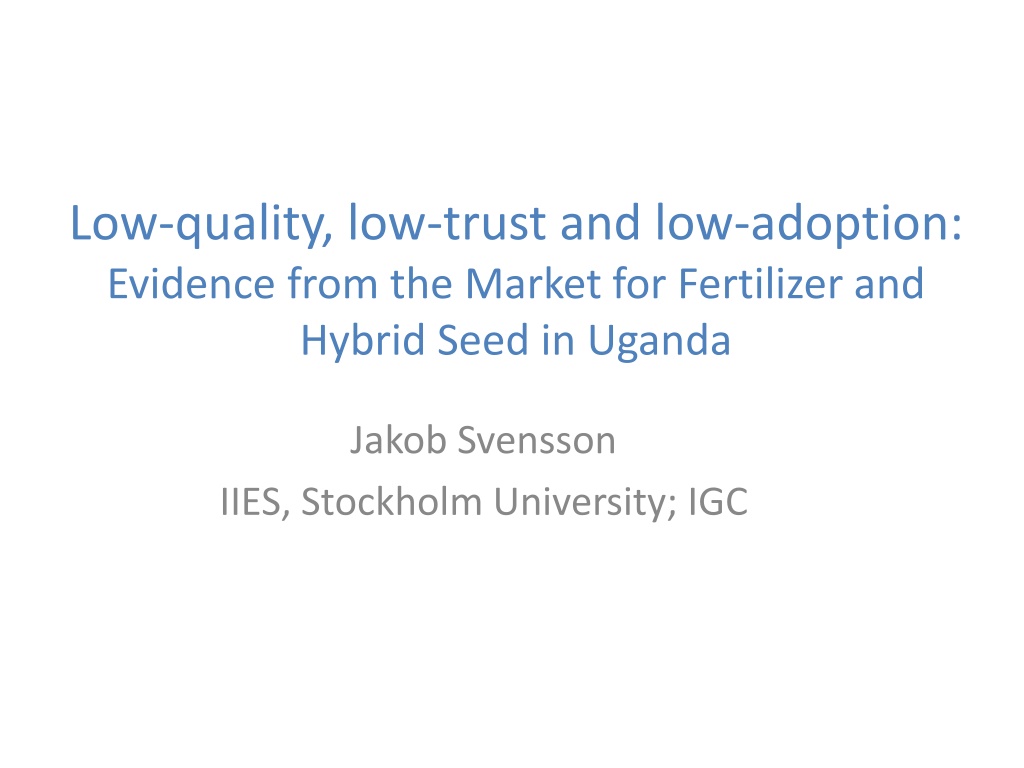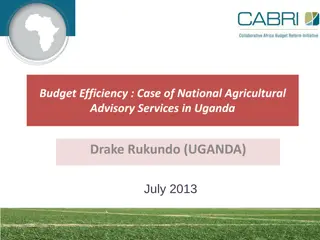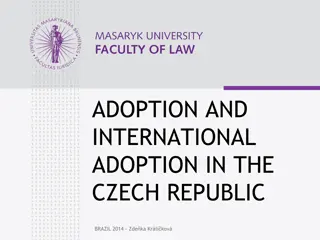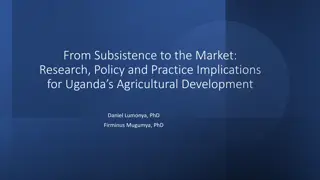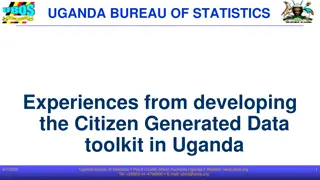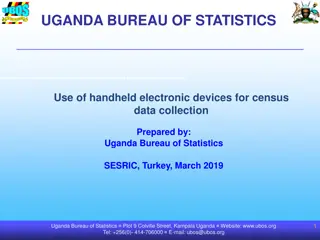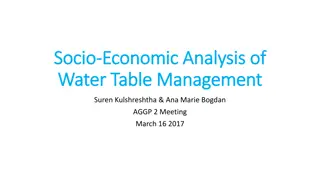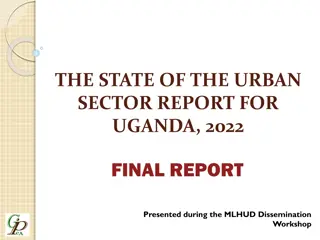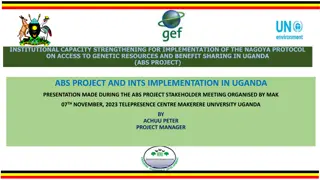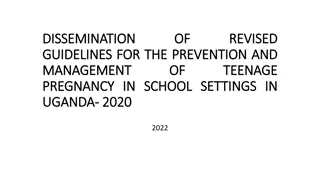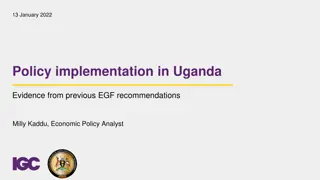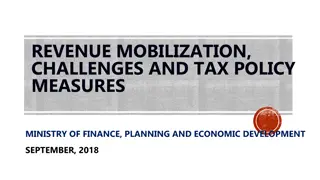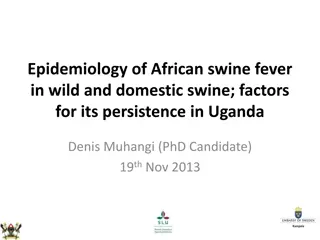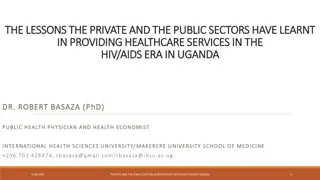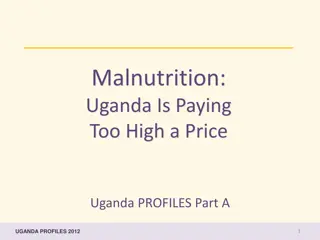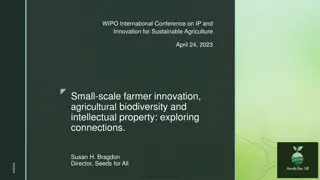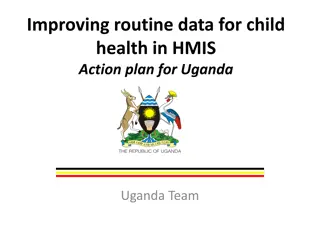Addressing Low Adoption of Modern Agricultural Technologies in Uganda
Market failures are hindering the adoption of high-yielding seed varieties and fertilizers by smallholder farmers in Uganda. Research suggests various constraints such as lack of information, credit, and insurance. A hypothesis is proposed, questioning if the technologies are not adopted due to adulteration, poor storage, or lack of profitability. The first large-scale study in Africa aims to assess the prevalence and economic returns of substandard fertilizers and seeds, focusing on maize varieties in Uganda. Data on nitrogen content and experimental yields are combined to measure technology quality in the market.
Download Presentation

Please find below an Image/Link to download the presentation.
The content on the website is provided AS IS for your information and personal use only. It may not be sold, licensed, or shared on other websites without obtaining consent from the author. Download presentation by click this link. If you encounter any issues during the download, it is possible that the publisher has removed the file from their server.
E N D
Presentation Transcript
Low-quality, low-trust and low-adoption: Evidence from the Market for Fertilizer and Hybrid Seed in Uganda Jakob Svensson IIES, Stockholm University; IGC
Starting point Low productivity in agriculture Low use/adoption of modern technologies (high-yielding varieties of seed and fertilizer), especially by smallholder farmers
Exploitable yield gaps for maize 6 5 4 MT/ha 3 2 1 0 Malawi Ethiopia Nigeria Uganda Mali Mozambique Average national yield Average yield in farm demonstrations
The question Why is the adoption of these technologies so low, especially for smallholder farmers ? Research has focused on market failures
Existing literature: Market failures Output market failures Lack of information and learning Credit constraints Lack of insurance Weak or imperfect property rights BUT, evidence of how important these constraints is mixed
Input market failures HYPOTHESIS: Is it possible that smallholder farmers do not adopt basic technologies as due to some combination of adulteration, poor storage and inappropriate handling procedures, the technologies are simply not profitable? Bold,Kaizzi, Svensson,Yanagizawa-Drott (2015)
What do we do First large-scale empirical assessment of the prevalence of, and economic returns to, substandard fertilizer and hybrid seed in Africa Investigate the quality of one of the most popular high-yield variety (HYV) maize seed in the Ugandan market, as well as a generic nitrogen-based fertilizer (urea).
What do we do To measure the quality of the technologies in the market, we combine data on the nitrogen content of fertilizer from retail shops (measured in a laboratory) and experimental yield data from our own agricultural trials.
Data Randomly sampled local retail shops and using a covert shopper approach purchased 300+ samples of urea fertilizer ( retail fertilizer ) 30+ samples of branded hybrid seed ( retail hybrid seed ), Purchased urea and hybrid seed in bulk from main wholesalers for urea ( authentic fertilizer ) seed company producing the branded seed ( authentic hybrid seed ) Purchased traditional farmer seed from a random sample of smallholder farmers
Measuring quality of fertilizers Each retail fertilizer sample was tested three times for the content of nitrogen (N) in the lab and we use the mean of these tests to determine the quality of a sample. Authentic urea should contain 46 percent nitrogen (%N) and we confirmed this to be the case in our authentic sample.
Measuring yield Researcher-managed agricultural trials Treatment: Fertilizers with %N= {0, 12, 23, 34, 46} Seed = { farmer , authentic , retailer } 15 possible seed-fertilizer quality combinations randomized into six 30m plots each at each of the five experimental sites
Market based fertilizers (UREA) contain 33% less nutrients (N) than authentic fertilizers Lab tests; %N .1 .08 .06 Density .04 .02 0 10 20 30 % N 40 50
Measuring dilution of retail seeds To assess the quality of retail hybrid seed, we focus on their yield response Find ? + (1- ) = Farmer Authentic Retail
Estimated level of dilution of hybrid seeds Mix of authentic and farmer seeds Retail hybrid seeds (1) (2) 0.55 (0.111) Mean 3.563 3.566 Variance 1.172 1.264 Skewness -0.058 -0.069 Kurtosis 2.437 2.123 0.004 Weighted sum of squared deviations
Measuring dilution of retail seeds 0.55 + 0.45 = Farmer Authentic Retail
Economic returns to adoption Modern technologies available in local retail markets are of poor quality What does this imply on the returns to adoption (of market quality inputs)?
Economic returns to adoption Unit of observation for these calculations is a retail fertilizer sample Approach: Determine the expected yield of a fertilizer sample j with nitrogen content ??%N, conditional on seed Calculate all costs of adoption and use market prices for maize
Economic returns to technology adoption Technologies available in the market (1) Authentic technologies Source: (2) -12.2% -8.6% 51.3% 51.0% Mean rate of return (r) Median rate of return (r) 18.4% 100.0% Fertilizer samples yielding positive rate of return (r) 1.4% 0.0% 0.0% 100.0% 100.0% 100.0% Fertilizer samples yielding rate of return (r) > 10% Fertilizer samples yielding rate of return (r) > 20% Fertilizer samples yielding rate of return (r) > 30%
Farmers beliefs Can poor quality of fertilizer and seeds and low rates of return help explain why farmers do not adopt modern inputs? Yes if (i) farmers expect that inputs in the market are of poor quality (ii) farmers expect high return on adoption of authentic inputs but not on market inputs
Farmers beliefs Elicit farmers beliefs about quality in the market and the yield generated from using inputs from the market
Farmers are aware that the quality in the market is low (37% less nutrients) Farmers Beliefs: % N in nearest shop .05 .04 .03 Density .02 .01 0 0 10 20 30 40 50 % N
Farmers beliefs Farmers know that using fertilizer increases yields, but that the increase depends on whether fertilizer is authentic or sourced from the market. A farmer planting owns seeds expects 1.47 MT/ha without fertilizer 2.53 MT/ha with market fertilizers 5.23 MT/ha with authentic fertilizer
Expected economic returns to fertilizer adoption Technologies available in the market (1) Authentic technologies Source: (2) -0.2% -52.2% 67.4% 10.5% Mean expected rate of return (r) Median expected rate of return (r) 26.5% 53.0% Farmers with expected positive net-return 24.4% 22.7% 21.3% 50.9% 46.3% 41.1% Farmers with expected rate of return > 10% Farmers with expected rate of return > 20% Farmers with expected rate of return > 30%
Discussion Poor quality inputs appear to be the norm in the local retail markets we surveyed Adoption of modern inputs with average retail quality is not profitable. The rate of return of using authentic fertilizer and hybrid seed is large, however. Implication: one reason smallholder farmers do not adopt fertilizer and hybrid seed is that the technologies available in local markets are simply not profitable
Avenues for future research/policy Low quality could be due to a multitude of factors adulteration, poor storage and inappropriate handling procedures. Quality deterioration could manifest at different points in the supply chain. Anecdotal evidence suggest that adulteration, by bulking out fertilizer or dyeing simple grain to look like hybrid seeds, is common, but more research is needed to determine if this is indeed the case. Exact reasons may be irrelevant for a farmer s decision to adopt, but important for policy.
Future research and policy We do not explain why the quality of agricultural inputs in local retail markets is poor, or how the problem should be tackled Results, however, suggest that the market is partly characterized by a low-quality, low-trust, low-adoption equilibrium. Specifically, the data show not only low average quality but substantial heterogeneity in quality which is not correlated with price. This suggests that the ability to infer quality may be severely limited, since we would otherwise expect prices to adjust.
Policy Need to know more about the underlying reasons for low quality Need to know more about farmers ability to learn about the technology when the quality of the technology is uncertain Identify policies to move to a different equilibrium? Monitor and enforce existing regulations Incentives to provide high quality inputs
Incentives to provide high quality inputs The incentives to build up and maintain a high quality reputation in weakly regulated and unmonitored markets may not be strong enough for the small and informal drug stores that currently dominate the market Suggest that policies to facilitate the entry of a larger firm, or a market chain, that can tap into consumers' ability to learn about and pay for quality may be an option to improve quality
Incentives to provide high quality inputs Link the seller of the technology (inputs) with the buyer of the output. Thereby making the seller a partial (indirect) claimant of what is being produced With fixed cost of buying, this provides the seller with incentives to ensure it supplies high quality inputs.
6 5 yield MT/ha 4 3 2 1 0 1960 1970 1980 1990 2000 2010 EAP LAC SA
6 5 yield MT/ha 4 3 2 1 0 1960 1970 1980 1990 2000 2010 EAP LAC SA SSA
Low adoption of modern technologies HYV maize as % of total crop area for maize 100 90 80 70 60 50 40 30 20 10 0 Sub-Saharan Africa East Asia & Pacific South Asia
Low adoption of modern technologies Kg of Fertilizer per ha of arable land 250 200 150 100 50 0 Sub-Saharan Africa East Asia & Pacific South Asia
